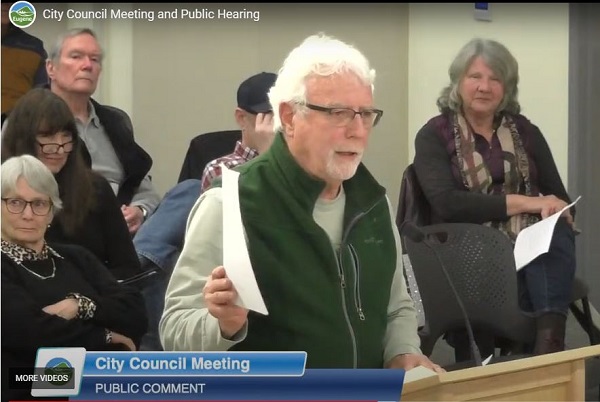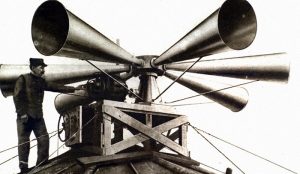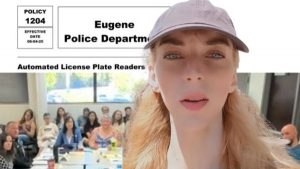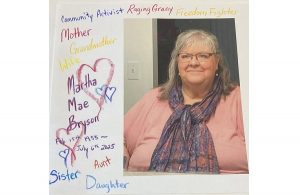Neighbors question safety of adding 2 more Franklin roundabouts
12 min read
Residents ask why the city is still moving ahead with roundabouts on Franklin Boulevard. At the public comment period Feb. 26:
Kay Rose: I’m Kay Rose. I live in the Fairmount neighborhood, I’m here to talk about Franklin Boulevard.
[00:00:13] I’m on the Fairmount board, who doesn’t want to take a stance on the issue, but in my workings and in the last year, I have had an overwhelming amount of neighbors that are very opposed to the roundabouts and very opposed to the way that it’s been handled, feeling like they gave public input and it hasn’t been taken seriously.
[00:00:29] You’re taking one of two major arterial roads from the east, the west side of town, and you’re turning it into a route best suited for everything but cars. There’s only one other alternative, the Beltline. Just like Agate and the two crosswalk signals on Franklin, cars will be trying to avoid students crossing staring at cell phones.
[00:00:52] This will not be safer for bikes who will have to use either the crosswalks or jump into multiple lane roundabouts, not as safe as a single lane roundabout, which have blind spots when cars change lanes.
[00:01:05] There’s a lot of studies been done that are not showing them safer for in multi-lane roundabouts and with EmX (bus rapid transit) and trucks driving back and forth. It just is like a roundabout on steroids. It’s like nothing of roundabouts that I’ve seen in other towns. If bike lanes were so important, why do we develop huge 12-story buildings right up to the street without room for around or room for bike lanes in front of them?
[00:01:32] EmX, LTD is not in favor of roundabouts. They’d like straight lines. They don’t have a commitment leading to extending bus service into our neighborhoods. The biggest concern we have is the neighborhood traffic that’s going to be avoiding all the congestion and probably looping up Walnut onto Fairmount Boulevard, dropping down where I live on Columbia. We’re seeing more and more of this going on.
[00:01:53] You’re pushing climate into our neighborhoods—I mean carbon—it’s not very friendly. The trees, the historic median trees, we’re being told they’re all going to be taken down from like I-5. These are trees that store carbon without any room to replant the trees—trees that should have required a vote, but now we hear there’s a loophole to allow the taking down of these historic trees.
[00:02:15] Emergency vehicles do not like roundabouts. Hospitals are now all in Springfield and this, it’s going to slow down people getting to them. The EmX vehicles and fire vehicles are not as effective using roundabouts.
[00:02:31] City of Eugene: Our next speaker this evening is Janet Harris.
[00:02:33] Janet Harris: I live in the Fairmount neighborhood, and having seen the design, I’m trying to figure out what it is—the solution—what problem it is trying to solve, and what it is that you want Franklin Boulevard to be? Is it the grand entrance to our city? Is it a thoroughfare? Is it a neighborhood street? Is it a bypass? Is it—I don’t know.
[00:02:56] And the design with the roundabouts doesn’t seem to address that. The roundabouts also seem to be very hostile to both cars and pedestrians. I don’t know how pedestrians get across an intersection like that, but you don’t see it in Springfield when they put those in.
[00:03:12] And then lastly, I just wanted to say that if one of the issues is automobile traffic and congestion, which I frequent that street all every day, I don’t see that, but if that’s an issue, one solution would be for LTD to restore a Fairmount bus route that goes up the hill. There’s currently no route that goes up the hill and there’s no sidewalks either. And so if you want to encourage public transportation, I would suggest a new bus route.
[00:03:44] Otto Poticha: Otto Poticha. I want to support the Franklin Boulevard transformation and concept development. This is an incredibly important project for our city. The present scheme, however, is typical Public Works Engineering, and not design. It is engineering.
[00:04:01] Have any of the special nature or special experiences within the corridor been incorporated? One’s experience and the special qualities of being in this major urban space, even in a vehicle, have not been explored nor presented.
[00:04:15] This Public Works-engineered solution could be dropped into any city and probably has. Engineering is an essential ingredient in any design, but tends to be quantitative or measurable. A design must pair the experiences of being and using the space to be a design.
[00:04:33] The presented design narrative has a paragraph that’s called ‘placemaking.’ All the words are there. The words are incredible. That’s absolutely what ought to be in this design. None of it is there. These are simply words out of a catalog somewhere.
[00:04:53] We’re asking: What are the principles or the process to finally incorporate human beings into this engineered solution? Most of our streets, 40% of the open space we own as the public, they’re called streets, corridors, parks. We don’t care for them. We only engineer them.
[00:05:14] I’ve made a list of questions that I would like answered. They can’t be answered tonight. I did print this and I’ll leave a copy here.
[00:05:25] But how is this a major introduction statement and entrance to our city? How could Judkins Point and other adjacent elements play a role as a part of this entrance? Should this corridor still use the term ‘boulevard’? Understand the definition of that term. It takes more than landscaping or plant masking to be a boulevard. Boulevards are like parks or park-like corridors and should be a special place.
[00:05:51] City of Eugene: Our next speaker this evening is Charles—
[00:05:53] Charles Frazer: Frazer, F-R-A-Z-E-R.
Why would a city knowingly adopt a traffic plan that cuts off an active growing community of 600 households from its only nearby grocery store, post office, and pharmacy?
[00:06:11] I’m from Laurel Hill Valley on the East side of the U of O and that’s the question I now ask the city council. Since 2019, when the first Franklin improvement design was revealed, my wife and I, along with other neighbors, pointed out that the Transportation Department plan resulted in isolating our community from central services.
[00:06:32] By eliminating the current left turn from Franklin onto Orchard Street, the plan makes it difficult and more hazardous for our residents to reach both Market of Choice and Hirons on Franklin as well as restaurants and businesses on the south side of the street.
[00:06:51] The correct traffic signal allows us to safely cross Franklin and directly enter the parking lot for those businesses. According to the traffic planner, in the future we’ll be required either to divert for several blocks through the Franklin neighborhood or make a U-turn at the intersection in front of Matt Knight’s arena and obtain access by going back in the other direction. Does this sound like a practical, safe, sensible traffic plan for a large neighborhood to reach everyday destinations?
[00:07:29] When we pointed out this design problem nearly five years ago, we were simply ignored. More recently, the planner told me that preserving our neighborhood access was not a design priority for this project.
[00:07:44] Last week in a presentation to Laurel Hill Valley Neighborhood Association, he used a slide listing the elimination of the left turn at Orchard Street as a main objective for the Franklin Improvement Project. When asked why, he avoided the question.
[00:08:02] So, as the city council, how can a project of this magnitude be proposed when it has such an obvious negative effect for so many people? And how can it proceed without a public hearing?
[00:08:15] Sue Crosby: Sue Crosby, native Eugenian. The city of Eugene refers constantly to public input and comments. Since the open house in February of 2023, I have asked to see the public comments. Forms were handed out and collected, and I asked that night when we could get to see them. No one on the staff that night could answer that question.
[00:08:33] No emails sent to the mayor and councilors got a response. I was told by one city councilor that you are required to have public input, but not required to publicly share it. This seems very disingenuous. This public input is referred to constantly, and I quote, ‘After five years and thousands of community suggestions, the design concept has been decided.’ So who did actually see all this community feedback?
[00:09:00] The project simulation, in my opinion, is a joke. It is very light traffic. If you’ve driven or walked or biked on Franklin Boulevard, it has a lot more going on than that little cartoon represents. There is much more traffic and …comments I have seen by engineers do not feel this concept is a good or safe design.
[00:09:18] In the city’s statistics from 2017 to 2021, it has a big number: 94 crashes, several resulted in death. How many? One is too many, but it seems this would be big news, and the community should hear more about it, and the locations and dangers should be public information. If this is largely due to speeding vehicles, and that is quoting the city, the solution would seem to be simple.
[00:09:42] It could be easily implemented by reducing the speed to 25 miles an hour and save all the construction hassles and disruptions like we saw for years on 6th, 7th and West 11th and save all the tasks. There’s a lot of money. Roundabouts are not a common and safe way to move traffic and pedestrians on the West Coast.
[00:10:02] Look at the two roundabouts by the bridge in Glenwood. Confused drivers and horns are frequent. And again, with a lot less pedestrian traffic, it seems that a few 25 mile an hour signs and EPD writing some tickets, that cars would slow down. Please consider the signs and not the rest of this.
[00:10:20] John Hirons: Good evening. My name is John Hirons. We own (the Hirons family owns) the shopping center, Market of Choice and Hirons. I want to introduce to you these folks: This is Up Campus (Properties). They’ve contacted us for elimination of the shopping center and replacing it with a high-rise student housing. You can see it all. I’m going to keep this copy. The city has proposed on Franklin Boulevard to close Market of Choice, as you heard before, their access on the northeast corner and eminent domain the property in front of Hirons, and add two roundabouts in the university area.
[00:11:04] If roundabouts are good, why are there not any roundabouts on West 11th?
[00:11:10] What did [Track Our Sports] over in Springfield (in Glenwood actually) say about roundabouts? They said: ‘Bring a bag of popcorn. Bring your lawn chair to the horn honking, see the road rage, and the victory signal (raised middle finger) from car to car. Their quote: ‘People just don’t know how to use roundabouts.’
[00:11:36] Now, let’s add two roundabouts as the city is proposing in the university area.
[00:11:42] You add 22,000 students to that, 5600 faculty and staff, 1142 beds of hotels and motels across the street and 1500 apartments on Garden Avenue. What does that give you? That transforms into pedestrians, bicycles, scooters, skateboards, and wheelchairs—very unsafe situation.
[00:12:04] My comment is, and I shouldn’t say this, but: ‘How many people do you plan to kill with roundabouts and an unsafe situation?’ Again, I’ll say the same thing: ‘People just don’t know how to use roundabouts.’
[00:12:17] And it was said before: What does (LTD CEO) Jameson Auten have to say about roundabouts?
[00:12:24] City of Eugene: Our next speaker this evening is Kathleen Frazer.
[00:12:28] Kathleen Frazer: I am not opposed to all roundabouts, but I am opposed to the five roundabouts plan for Franklin Boulevard. I believe they are unnecessary and will cause many more problems than they solve.
[00:12:39] I live in Laurel Hill Valley. It now takes me five minutes to get to Market of Choice or Hirons. If the reconstruction happens and the left turn at Orchard is eliminated, I will have to navigate three roundabouts and make a U-turn at Villard, the very busy intersection by the basketball arena. Are the 700-plus households from our neighborhood expected to do that? It makes no sense.
[00:13:02] I have collected hundreds of signatures from people who do not want five roundabouts on Franklin. Most responders are shocked and horrified that this is being considered. Truckers don’t like it. LTD doesn’t like it. Drivers don’t like it. Emergency responders don’t like it.
[00:13:17] Where is the evidence that this is a priority for the city? It appears that all the research supporting this plan is many years old. Where is the current research that tells how England is removing roundabouts and replacing them with signaled intersections because they are safer for bicycles?
[00:13:35] Why hasn’t an underpass been considered? Why remove the mature oaks in the median? They make a beautiful entrance to our city from the east. When I asked about that, our city councilor said, and I quote: ‘I hate those trees.’
[00:13:49] Our neighborhood is hilly, has no bus service, limited sidewalks, and many older adults or families with small children. So we depend on our cars to get into town. Five roundabouts makes it complicated. Why here and not somewhere that has more traffic accidents?
[00:14:06] Research shows that roundabouts are not suitable for congested areas. Certainly, taxpayer money could be spent on something more worthwhile. Please put an end to this ridiculous plan.
[00:14:17] Thomas Bruno: I’m Thomas Bruno. My background is a combat arms officer. The army sent me to get a master’s degree in logistics. And after I was medically retired, I put that education to use.
[00:14:31] And so I’ve been a member of the Society of Logistics Engineers. I’ve done a lot of transportation algorithms. I’ve done a lot of queuing. And I’ve written textbooks and professional journals.
[00:14:45] I’ve asked my contemporaries about the five traffic roundabouts. They essentially said this looks like a solution for a problem that is ill defined.
[00:14:57] I’m really concerned about emergency vehicles. I’ve asked for all the data, the transportation analysis. I can run my models. I’ve got 12—software that does modeling. I’ll be glad to do the independent verification and validation on the project. But I don’t see the safety aspects that the city is talking about. Specifically, Zero Vision doesn’t even list Franklin Boulevard as one of the issues.
[00:15:27] The major drawbacks of an increased heavy traffic is congestion. We’ve talked about tunnels. They’ve talked about everything.
[00:15:36] My son is a nephrologist in Davis, California. My daughter in law is a professor. They have no school buses in Davis. The kids go to school on their bicycles. My 16- year-old grandson went to elementary school half a mile away, a mile and a quarter for his middle school and 2.5 miles away for his high school. I have an EV down there because I have a lung fungus and I ride with him when we go to dinner.
[00:16:05] I’m very familiar with the transportation at Davis, California. Davis has five roundabouts in the entire city. And the city is asking for four roundabouts in four-tenths, four-fifths of a mile.
[00:16:21] Eric Bergland: My name’s Eric Bergland. I grew up in Laurel Hill Valley. My mom still lives there. And I moved back here recently from Seattle, Washington, where I did spend roughly 12 years doing route and public transportation planning for King County and the city of Seattle.
[00:16:38] I’ve seen a lot of transportation boondoggles in my life. This plan seems to be at least partially one of those.
[00:16:48] One of the things that I take issue with, and I’m going to parrot Mr. Bruno a little bit here. And that is that the city’s own Zero Vision research does not list Franklin Boulevard anywhere near, or in the top 15 most dangerous roadways in Eugene. And yet this project seems to be addressing a problem that doesn’t exist.
[00:17:16] When I think of emergency services along this corridor—especially given the fact that the emergency room at the university is now gone—the eventual accidents that are bound to happen on this roadway, the only place will be to go obviously out to PeaceHealth in Springfield.
[00:17:37] What I see is a waiting sort of disaster or trap for patients who are injured along that roadway. I don’t see a safe or quick way to get emergency vehicles from Franklin Boulevard to PeaceHealth. I think it’s going to cost lives. And this is a poorly thought-out project.
[00:17:58] John Q: New questions about adding two roundabouts on Franklin, and a request to see past public comments on the design.



